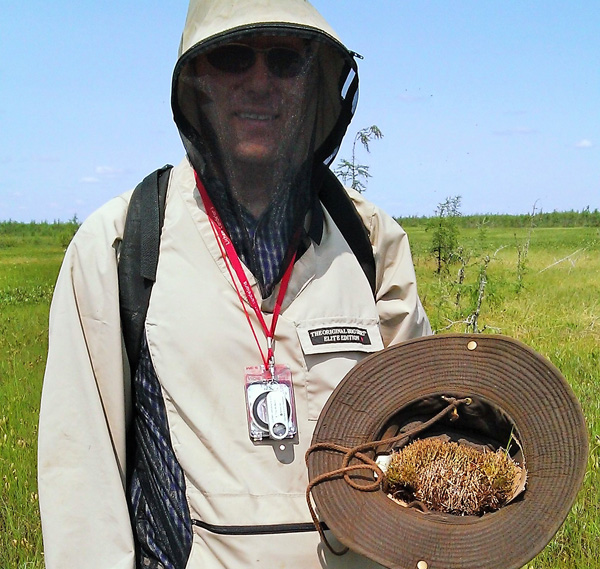One of the great things about traveling in far northern Ontario this July was the fact that our multi-disciplinary botany team included a lichenologist.
It was great because lichens are amazing, because lichen experts are very rare, and because there’s so much left to learn in lichenology that every lichen outing seems to result in spectacular discoveries.

It was also great timing, because we’ve been making the (already ultra-cool) temporary exhibition Creatures of Light even better by adding material from the Museum of Nature’s research and collections… and as it turns out, some lichens are dazzling creatures of light.
Dr. R. Troy McMullin of the University of Guelph generously collaborated with me in finding specimens to share with museum visitors (I’ll also be adding specimens to the museum’s collections).
Lichens aren’t bioluminescent, which is to say that if you turn out the lights, they won’t glow in the dark. Under ultraviolet light, however, many of them fluoresce, glowing vividly in ways that most humans can’t detect in normal daylight conditions.

Sometimes the colours of fluorescing lichens under UV light (also called black light) appear completely different from what appears to dominate under ordinary white light. This means, for example, that a bone-white lichen may appear a startling egg-yolk yellow under black light.
Intriguingly, scientists have not yet determined why only some lichen species contain fluorescent chemicals. They have determined, however, that they are natural by-products of the lichens’ daily life.
I have to admit that although I’ve known for decades that black lights are standard equipment in lichen identification labs, I didn’t realize how common it is to encounter fluorescent lichens in Canada. Their almost flamboyant glow makes them seem like they should be more exotic.

In the Hudson’s Bay Lowlands, however, Dr. McMullin routinely pointed out clumps of lichen for prospective display. Of one ubiquitous, brownish, stick-like specimen, he commented, “This one glows blinding blue”.
Blinding blue?! And it’s growing in every Canadian province and territory? How come no-one tells us these things in school?

When I wondered aloud what it might be like to turn a northern bog psychedelic with UV floodlights, Dr. McMullin referred me to another lichenologist, Dr. Robert Lücking, and the astonishing photo that resulted when he set up his black light next to a lichen-encrusted tree trunk. Dr. Lücking graciously shared that photo, and one of the same tree under white light, which you can see here.

As another group of lichenologists introduced them, “Lichens… belong to an elite group of survivalist organisms…”. They are tough, beautiful, unique, and puzzling. And far from being confined to remote northern peatlands, they also grow in back yards, on concrete steps and on city tree trunks, not to mention parks and natural areas—every terrestrial environment, except for the most heavily polluted regions of our planet.

The real mystery is why so few people know about them. If you want to see them, step outside. If you want to see them fluoresce, stop by Creatures of Light at the museum, any time before November 9, 2014.
Jennifer covered a lot of ground on this collecting trip. Read her previous article, Blackflies, Begone! Studying the Plants of Northern Ontario’s Peatlands.

Reblogged this on Old School Garden.
I would have to disagree that there are no lichens that glow in the dark! I have seen them many times,at one time my science teacher identified it as a glow in the dark lichens, White lichens growing flat on a dead branch that had a greenish glow at night in the woods. if you would like I am sure i can find some for you!
Hi Tim, being a new student of lichenology and interested in ‘glowing’ listens I’m intrigued by your post. Can you enlighten us further please?
Max
Max, I am no expert but when I was a kid I used to walk through our woods at night to go to the neighbors probably a two mile hike in the dark. One night I noticed something glowing kind of greenish white glow it was on a dead tree branch. I picked up the branch and took it home in the light to me the only way to describe it would be lichens much like the green lichens on trees but only more white. This lichens was fairly dry and well attached to the branch. I was curious as to what it was so I took it in to my science teacher, right off he also said it was a lichens. The teacher was very intrigued we took it in a very dark room and it indeed glowed not as brilliant as it did the night before but nonetheless it was still glowing. I used to go looking for it, I found it many times, at one area I swear it was growing on a rock. So you tell me what kind of mushroom grows on a rock! Wisconsin.
Fascinating article Jennifer thank you! There appears to be very little info on this subject and my browser found yours first!
This is a very good tip especially to those new to
the blogosphere. Short but very precise information? Appreciate
your sharing this one. A must read article!